Succulents and cacti are not just for the desert. They also do well inside your home. They add beauty with little work. To care for a Jade Plant, follow some easy tips.
Jade Plants are known for bringing luck and money. They make your home air cleaner and happier. This can make you feel better and work better.
Knowing what your Jade Plant needs helps it grow well. It makes your home look natural and beautiful. Whether you’re new to plants or not, Jade Plant care is easy. With the right tips, you’ll enjoy having this amazing plant at home.
Understanding the Jade Plant: A Symbol of Prosperity and Good Fortune
Learning about Jade Plant care is exciting. It’s about understanding its history and cultural value. This succulent comes from South Africa and has been loved for centuries. It’s known for its beauty and for bringing luck and wealth.
It’s easy to care for a Jade Plant. It needs water only sometimes and good drainage. By following care tips, your plant will grow well. It also cleans the air, making it great for homes and offices.
History and Origins of Jade Plant
The Jade Plant has a long history. It’s a symbol of luck and wealth in Feng Shui. Its thick leaves and tree shape make it a favorite in many places. Adding a Jade Plant can bring positive energy and success.
Cultural Significance in Feng Shui
In Feng Shui, the Jade Plant is very special. It’s believed to bring luck and success. Placing it in the southeast corner can attract wealth. Its easy care and air-purifying qualities make it a top choice.
Physical Characteristics and Varieties
The Jade Plant comes in many shapes and sizes. From the small Gollum jade to the tall Variegated jade, there’s one for everyone. With the right care, your Jade Plant will be beautiful for years. Following a care routine will help it thrive.
Essential Care Guidelines for Your Jade Plant
To keep your Jade Plant happy, you need to know the basics. It likes bright, indirect light. This is perfect for rooms with south-facing windows. Direct sunlight can hurt its leaves.
Watering is also important. Water your Jade Plant only when the soil is dry. Too much water can cause root rot. Too little water can make leaves fall off. Water it once a month in winter and more often in spring and summer.
For soil, choose something that drains well. A succulent potting mix is best. The soil should be slightly acidic, between 7 and 5.5 pH. Follow these tips to care for your Jade Plant well.
| Lighting | Watering | Soil |
|---|---|---|
| Bright, indirect light | Sparingly, allowing soil to dry out | Well-draining, succulent potting mix |
By following these Jade Plant care tips, you’ll give your plant the best chance to thrive. Remember, the right balance of light, water, and soil is key. Pay attention to your Jade Plant’s specific needs.
Potting Too Much: Choosing the Right Container
Choosing the right container for your Jade Plant is key. The right pot can greatly affect your plant’s health. Best materials for Jade Plant pots are terracotta and clay. They let air and water move well.
A good pot size is just a bit bigger than your plant. For example, a 4-inch plant fits well in a 5-inch pot for 1-2 years. Make sure the pot has holes for water to drain. This stops water from building up and harming the roots.
Here are some important things to think about when picking a pot:
- Choose a pot that matches your Jade Plant’s size
- Make sure the pot has holes for water to drain
- Think about the pot’s material. Terracotta and clay are good choices
By following these tips, your Jade Plant will do well. It will have beautiful, lush leaves.
| Pot Size | Plant Diameter |
|---|---|
| 4-6 inches | Seedlings |
| 6-8 inches | Young plants |
| 10-12 inches | Mature plants |
The Importance of Fertilizing Your Jade Plant
Understanding fertilization is key to caring for your jade plant. A good Jade Plant care guide will tell you to fertilize. This step helps your plant grow strong and healthy.
Choose a balanced, water-soluble fertilizer made for succulents. Look for a mix with a 10-10-10 or 20-20-20 N-P-K ratio. Websites like trusted houseplant guides can help with watering tips.
Fertilize every four to six weeks in spring and summer. Use a weak solution to keep the roots safe. Here’s a quick guide:
| Fertilization Period | Frequency | N-P-K Ratio |
|---|---|---|
| Active Growing Season (Spring and Summer) | Every 4-6 weeks | 10-10-10 or 20-20-20 |
| Dormant Period (Fall and Winter) | Every 2 months or skipped | Not applicable |
By following these tips, your jade plant will thrive. Always water before fertilizing to protect the roots.
Common Pests and Diseases Affecting Jade Plants
When you start caring for Jade Plants, knowing about pests and diseases is key. By following the right care steps, you can avoid many problems. Regular checks help catch issues early, so you can act fast.
Common pests like mealybugs, spider mites, and scale can harm Jade Plants. Mealybugs are especially bad, causing damage and even death if not treated. Look for white, cottony stuff on leaves or stems to spot pests. Use insecticidal soap or neem oil to fight them, and remove any sick parts to stop disease spread.
Diseases like root rot and leaf spot can also hit Jade Plants. Root rot happens when plants get too much water, causing yellow leaves. Leaf spot comes from too much moisture, not enough sun, or sudden temperature changes. Knowing why these diseases happen helps you prevent them, keeping your Jade Plant healthy.
To avoid pests and diseases, follow good Jade Plant care. Give them the right light, water them right, and use soil that drains well. By doing this and watching your plant closely, you’ll enjoy a happy, healthy Jade Plant.
| Pest/Disease | Causes | Symptoms | Treatment |
|---|---|---|---|
| Mealybugs | Infestation | White, cottony patches | Insecticidal soap or neem oil |
| Root Rot | Overwatering | Yellowing leaves | Remove infected roots, improve drainage |
| Leaf Spot | Environmental stressors | Brown or black spots | Remove infected leaves, improve air circulation |
Propagation Techniques for Jade Plants
Learning how to care for a Jade Plant means knowing how to grow new ones. You can use leaf or stem cuttings to do this. It’s important to follow the right steps for success.
Timing is key when it comes to growing new Jade Plants. They can be grown all year, but they grow faster in spring and summer. This is the best time to grow them. Also, stem cuttings make bigger plants grow faster than leaf cuttings.
Leaf and Stem Cutting Methods
To grow a new plant from a leaf, twist or cut off a healthy one. Let it dry for a few days to form a callus. Then, plant it in soil that drains well and water it a little until roots grow.
To grow a new plant from a stem, cut a section from the mother plant. Remove lower leaves and let it dry for a few days. Then, plant it in soil that drains well and water it a little until roots grow.
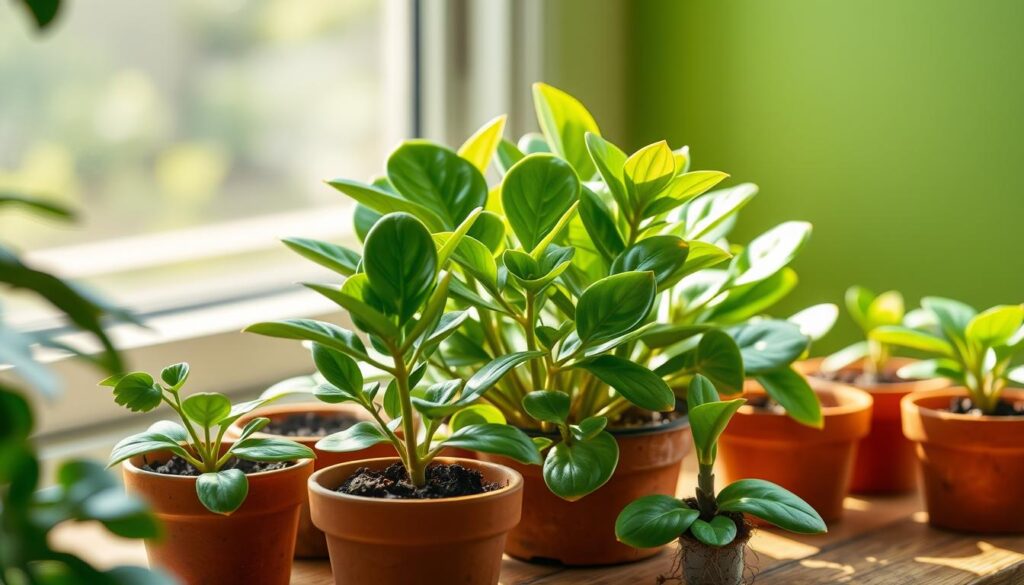
Timing and Seasonal Considerations
Think about the time of year when growing your Jade Plant. They grow faster in warmer months. A leaf can start growing roots on its own if it falls off.
It usually takes 2 to 3 weeks for Jade cuttings to grow roots. By following these tips, you’ll be able to care for your Jade Plant and share it with others.
Jade Plant Pruning: When and Why
As you care for your jade plant, you’ll need to prune it. Pruning keeps it healthy and looking good. It makes your jade plant fuller and more beautiful in your home.
Prune your jade plant in the spring or early summer. This is when it grows the most. Pruning at this time helps it heal fast and keeps it safe from diseases.
Benefits of Pruning
Pruning your jade plant has many benefits. It makes the leaves grow closer together and the trunk thicker. It also helps shape the plant into a bonsai or any shape you want. Pruning makes your jade plant strong and healthy.
How to Properly Prune Your Jade Plant
You’ll need sharp scissors or pruning shears to prune your jade plant. Cut off any dead or damaged parts. Cut long stems to make the plant bushy. You can also shape the plant by cutting branches.
- Prune your jade plant at least once a year for optimal growth and health.
- Prune during the spring or early summer, when the plant is actively growing.
- Remove no more than 20-30% of the plant’s branches at one time to avoid shocking the plant.
- Use a 45-degree angle when cutting back branches to encourage compact, thick new growth.
Follow these tips to make your jade plant thrive. With proper care, it will grow into a beautiful and healthy plant.
| Pruning Technique | Description |
|---|---|
| Formation pruning | Trim side shoots by up to 50% for upward growth and by 1/3 for the trunk for outward growth. |
| Relief pruning | Cut drooping branches approximately 3 inches above the bend. |
| Rejuvenation pruning | Cut old branches back to where they meet the trunk and shorten sparse branches by 1/3, keeping at least two pairs of leaves. |
Indoor versus Outdoor Jade Plant Care
When caring for your Jade Plant, the environment matters a lot. You can grow it indoors or outdoors, based on your climate and what you like. For indoor care, give your Jade Plant bright, indirect light. Keep the temperature steady between 65-80ºF.
For a good Jade Plant care routine, check the soil moisture often. Fertilize with a balanced houseplant fertilizer at a low dose twice a month from spring to late summer. Learn more about Jade Plant care and how to make your plant happy.
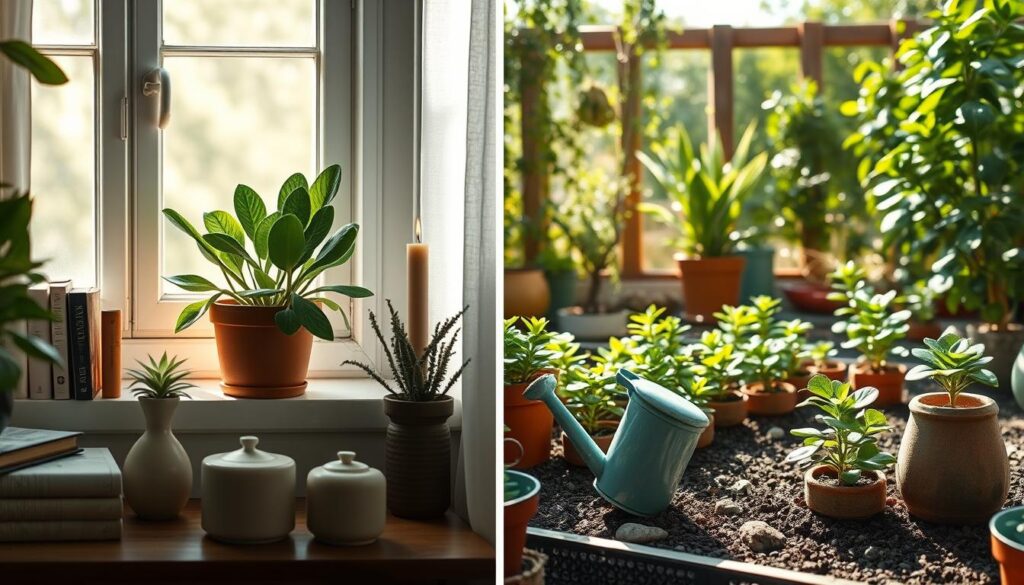
- Lighting: Provide bright, indirect light, such as near a south- or west-facing window.
- Temperature: Maintain a consistent temperature between 65-80ºF.
- Watering: Check the soil moisture regularly and water only when the soil is completely dry.
By following these tips and making a good Jade Plant care routine, your plant will thrive. You’ll get to enjoy its beauty and symbolic meaning in your home.
Signs Your Jade Plant Needs Attention
To keep your Jade Plant happy, watch for signs it needs help. Jade Plant care is all about the right amount of water. Too much water makes leaves turn yellow and stems droop. Not enough water makes leaves wrinkle and soil dry out.
Some common signs that your Jade Plant needs attention include:
- Yellowing or wrinkled leaves
- Droopy stems or dry soil
- Lack of growth or compact structure
Spotting these signs helps you fix your Jade Plant care. This keeps your plant healthy and happy.
By following Jade Plant care tips, you’ll enjoy this easy-to-care-for plant. With the right care, your Jade Plant can live up to 70 years. It brings good luck and prosperity to your home.
| Signs of Overwatering | Signs of Underwatering |
|---|---|
| Yellowing leaves, droopy stems, waterlogged soil | Wrinkled leaves, dry soil, lack of growth |
Creating a Thriving Environment for Your Jade Plant
To help your Jade Plant thrive, pair it with plants that need similar care. Jade plants go well with succulents like Echeveria, Sedum, and Sempervivum. These plants look good together and meet their needs.
Change your Jade Plant’s care as the seasons change. In warmer months, water it more and give it more sunlight. When it gets cooler, water it less and keep it in indirect light. This helps your Jade Plant stay healthy and look great all year.
FAQ
What are the essential care requirements for a Jade Plant?
How often should I fertilize my Jade Plant?
What are common pests and diseases that affect Jade Plants?
How do I propagate a Jade Plant?
How do I know if my Jade Plant is getting too much or too little water?
Can Jade Plants be grown outdoors?
If you are really in love with gardening see Michelles YouTube Channel for all things plants.
If you would like to check out other beautiful members of the Succulents category look here at our article of 12 Stunning Indoor Succulents and Cacti


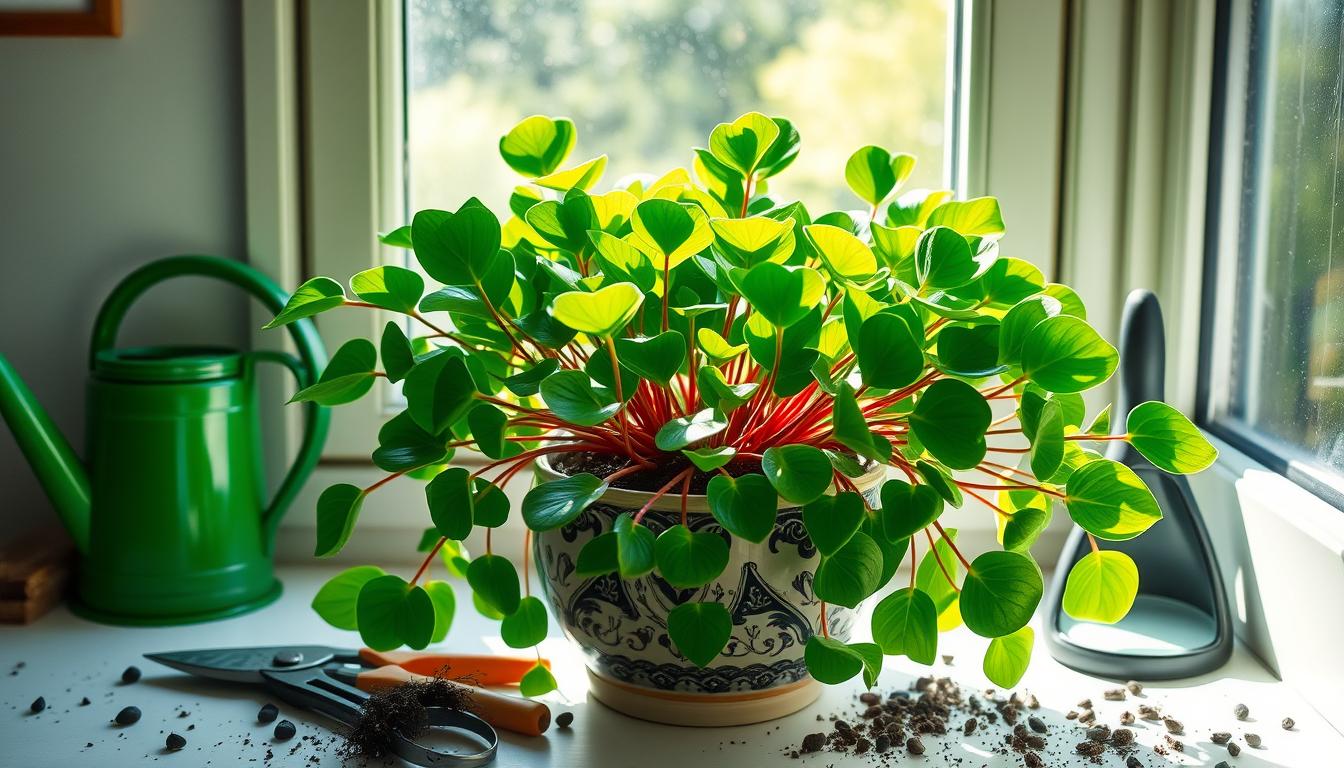
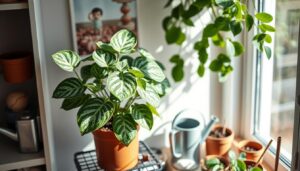
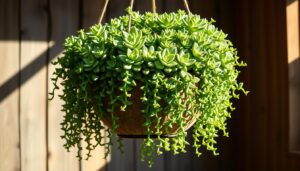

Pingback: 12 Stunning Indoor Succulents and Cacti for Your Home - Trusted House Plant Guide
Pingback: The Ultimate Guide to Houseplants: 100 Best Indoor Plants for Every Home - Trusted House Plant Guide